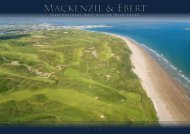Royal Troon 145th Open Booklet
You also want an ePaper? Increase the reach of your titles
YUMPU automatically turns print PDFs into web optimized ePapers that Google loves.
The Old Course at<br />
<strong>Royal</strong> <strong>Troon</strong>
A Pure and Historic Seaside Links<br />
All Photographs Copyright Getty Images Unless Otherwise Stated
Introduction<br />
The <strong>Open</strong> returns to the Old Course at <strong>Royal</strong> <strong>Troon</strong> for the ninth time in 2016. Like so many<br />
historic links, the course starts with the front nine running closest to the coast line. In fact no links<br />
starts closer with the 1st tee touching the very edge of the beach. The front nine also enjoys the<br />
most famous par 3 on The <strong>Open</strong> rota and also its shortest hole at just 123 yards. The wonderful<br />
Postage Stamp leaves even the highest calibre of golfer thinking of what tragedy might befall them<br />
if the short iron is even a hair off line.<br />
However, it is the back nine which provides the most challenging of examinations which every<br />
Champion Golfer of the Year must pass to hold the Claret Jug aloft. In 2004, the 10th, 11th and 12th<br />
holes were ranked the third, first and second most difficult holes respectively. What a test that<br />
triumvirate of holes presents. The back nine continues with seriously strong par 4s at the 13th,<br />
15th and 18th which were all ranked in the set of nine most difficult holes for the week.<br />
If there is any question mark which is occasionally raised about the course it is a concern that the<br />
first few holes are too easy but courses come in all shapes and sizes and every layout has its own<br />
rhythm. At <strong>Royal</strong> <strong>Troon</strong>, everyone knows that the scoring normally has to be made in the early<br />
part of the round. That brings its own pressure and potential for a loss of patience if the birdies do<br />
not fall.<br />
Following The <strong>Open</strong> in 2004, a review of the course was commissioned by The R&A, in line with<br />
a study of all of The <strong>Open</strong> venues to assess how they might be improved to be most suitable for<br />
the modern day game. All of the great courses have evolved regularly over many years for a variety<br />
of reasons so it is the right thing to conduct reviews intermittently as long as such studies are<br />
sympathetic to the heritage of a course and club. Any adjustments must also bear in mind the fact<br />
that courses which champions play over to claim their spoils have to be enjoyable places to play for<br />
the club members and visitors for more than 99% of the time.<br />
One aspect which is worth drawing attention to at <strong>Royal</strong> <strong>Troon</strong> is that the review of the Old Course<br />
did not result in a major lengthening exercise being undertaken. The course length was 7,175 yards<br />
in 2004 and will play at 7,190 yards in 2016. It was only considered necessary to lengthen a few<br />
holes and by a minor amount.<br />
The review included conducting as much historical research into the evolution and development<br />
of the course as possible. Club archives were looked into, old newspaper cuttings assessed, past<br />
aerial and ground photography was sourced and analysed and a wonderful illustration of the<br />
layout for The <strong>Open</strong> in 1923 was unearthed. In addition, Club members with long memories and<br />
former members of the greenstaff were quizzed. That has helped to shape the proposals which<br />
were considered by the Club and The R&A and led to the implementation of certain adjustments<br />
which are described in this booklet.<br />
While there have been some new developments for the course, a large majority of the adjustments<br />
could be described as restoration of old characteristics and features. After the Prestwick<br />
greenkeeper, Charlie Hunter, and <strong>Troon</strong> professionals George Strath and Willie Fernie carried<br />
out the early work in laying out and developing the course at <strong>Troon</strong>, James Braid was responsible<br />
for toughening the layout for its first <strong>Open</strong> in 1923. <strong>Troon</strong>’s Portland Course, originally laid<br />
out by Willie Fernie in 1895, was redesigned by Dr Alister MacKenzie in 1921 and was used for<br />
qualifying in The <strong>Open</strong> in 1923. Whilst at <strong>Troon</strong>, the Club received advice from Dr. MacKenzie<br />
on remodelling the bunker at the 10th hole of the Old Course. This is the only clearly identifiable<br />
feature on an <strong>Open</strong> course upon which he provided input.<br />
While minor adjustments have been made to every hole for The <strong>145th</strong> <strong>Open</strong> in 2016, the major<br />
changes to the course have focussed on the 9th, 10th and 15th holes, with those at the 10th and<br />
15th involving the restoration of old features.
Historical Research<br />
Conducting historical research into the evolution of a course of<br />
significant heritage should always form the start of any review<br />
exercise. It helps to provide an understanding of why a course<br />
has changed and often generates inspiration for adjustments<br />
which could be more accurately described as restorations. The<br />
Old Course at <strong>Royal</strong> <strong>Troon</strong> actually provides an excellent study<br />
of golf course architecture, particularly of architecture for<br />
championship golf. A study of the evolution of the course from<br />
its foundations, shows how championships, and especially The<br />
<strong>Open</strong>, have shaped its character.<br />
The Early Years<br />
The Club’s first Captain, James Dickie, was well acquainted with<br />
<strong>Troon</strong>’s natural seascapes of beaches and dunes. The links just<br />
to the south of the town presented exactly the right conditions<br />
to lay out a course. This task was carried out by Charlie Hunter,<br />
Keeper of the Green at Prestwick Golf Club, who had served his<br />
apprenticeship under the legendary Old Tom Morris. Six greens<br />
were laid down, some still in play today.<br />
George Strath was appointed the Club’s first Professional in 1882<br />
and he extended the course to twelve and then eighteen holes<br />
with the full course opening in 1884 forming much of the layout<br />
played today.<br />
Willie Fernie, Champion Golfer of the Year in 1883, was<br />
appointed Professional at <strong>Troon</strong> Golf Club in 1888. During his<br />
36 year tenure, he was responsible for many improvements to<br />
the Old Course including designing and laying out the Postage<br />
Stamp and Railway holes in 1909. In order to add the Postage<br />
Stamp to the layout, Fernie ran two holes together to form the<br />
current long 6th hole and, instead of playing to the 9th green<br />
from the tee of the Postage Stamp, added in the famous par 3 and<br />
lengthened the 9th on its current line. Similarly, following the<br />
creation of the new 'Railway' hole, the original 15th and 16th holes<br />
were merged to create the current par 5 16th. This added length<br />
and difficulty to the course but Fernie also managed adjustments<br />
such as moving the 18th green, which had previously had a semiblind<br />
approach, to its current iconic position in front of the<br />
clubhouse and enlarging the previously small 7th green. These<br />
changes ensured <strong>Troon</strong> was no longer a sporty holiday course<br />
but one ready to entertain championship play.<br />
The Development of the Course & Arrival of The <strong>Open</strong><br />
In 1914, the course hosted qualifying for The <strong>Open</strong> at Prestwick<br />
and, once the trauma of WW1 was over, the course was ready<br />
to develop further when the chance came. The opportunity<br />
arose in 1921, when the proposed host course of The <strong>Open</strong> in<br />
1923, Muirfield, withdrew due to planned major reconstruction.<br />
<strong>Troon</strong> member and 1914 Amateur champion, JLC Jenkins, was<br />
on The R&A Championship Committee and proposed his home<br />
course as a suitable alternative. In order to ensure the course was<br />
a fitting test for the premier championship in golf, James Braid<br />
was approached to cast his expert eye over the links.<br />
Braid, as well as being Champion Golfer of the Year five times,<br />
had developed into a noted course architect and he oversaw a<br />
number of major changes to the Old Course. Some alterations<br />
were predictable with a number of new back tees being<br />
constructed but others profoundly altered the course. The<br />
Aerial view from 1923 of the 18th green clearly shows<br />
the outline of the 13 bunkers that James Braid scattered<br />
around the green surface<br />
biggest single change was at the 5th, which changed from a<br />
short par 4 low in the dunes to a par 3, up high and overlooking<br />
the ocean. Another notable change was the addition of 67 new<br />
bunkers around the course, almost doubling the number. These<br />
included the bunkers to the left of the Postage Stamp, removing<br />
the option of running a shot off the mound, and leaving the hole<br />
essentially as it is today. He also surrounded the 18th green with<br />
13 bunkers. If you look carefully today, many of the current<br />
swales give clues as to their locations.<br />
At the 10th hole a subtle change to the large bunker on the sand<br />
dune facing the tee was carried out. The large bunker, originally<br />
created in 1887/8 by either George Strath or Willie Fernie, had,<br />
by 1914, undergone several changes. In preparation for The<br />
<strong>Open</strong> in 1923, Dr Alister MacKenzie provided advice, accepted<br />
in January 1921, on remodelling the bunker. MacKenzie later<br />
depicted the bunker in his pamphlet 'Hints on Greenkeeping'.<br />
Image Copyright NCAP / ncap.org.uk
British golfer Joyce Wethered plays to the 6th green during<br />
the Ladies <strong>Open</strong> Golf Championship in 1925<br />
The 91st <strong>Open</strong> in 1962<br />
While The <strong>Open</strong> in 1950 was deemed to be a success, scoring<br />
had been low and it was felt that the length at 6,500 yards,<br />
with some 8 par 4s shorter than 400 yards, meant a general<br />
toughening of the course was required for the sort of rigorous<br />
examination The <strong>Open</strong> should provide. As a result, new tees<br />
were added but the major changes were a new green at the 4th,<br />
adding 80 yards to the hole, and a complete remodelling of the<br />
11th with a new green 170 yards further along the railway wall.<br />
This essentially created the renowned and feared hole that the<br />
current prospective champions now face.<br />
The outcome was 18 holes that measured over 7,000 yards. In<br />
the end, Arnold Palmer won with a score three shots lower than<br />
Bobby Locke's total 12 years previously. However, he won by<br />
playing what he described as the best golf of his life and, at 12<br />
under par, was 6 shots clear of Kel Nagle in second place, who<br />
was the only other player under par. The course, and certainly<br />
the new 11th, was now tough enough, while still rewarding of<br />
truly outstanding play. However, the real legacy of The <strong>Open</strong><br />
in 1962 was its aftermath. After the event, the championship<br />
became known as the first <strong>Open</strong> of the modern era, as Palmer's<br />
play encouraged record crowds, frequently overwhelming the<br />
archaic facilities, and this would become a major factor in future<br />
changes to the course.<br />
The Modern Era<br />
Since 1962, The <strong>Open</strong> has returned regularly to <strong>Troon</strong>. On the<br />
face of it not much has changed. In an era when modern<br />
equipment has forced many courses to seek hundreds of yards<br />
in extra length, <strong>Troon</strong> plays a mere 145 yards longer. However,<br />
every time The <strong>Open</strong> has come, the course has been tweaked in<br />
advance. There are far too many changes to list here but there<br />
are a few worthy of note.<br />
The most drastic was the moving of the 6th and 12th greens,<br />
which were deemed a bottleneck for spectator traffic in 1962.<br />
The old 6th green was in a fearsome location and the hole always<br />
rated a mention in older books and magazines when the topic of<br />
the best par 5 in the country was<br />
being discussed. Similarly, ask any<br />
older golfer who remembers the<br />
original 12th and they will bemoan<br />
the loss of a visually impressive<br />
approach shot through the dunes.<br />
This was believed to be the first<br />
time any course on The <strong>Open</strong><br />
rota had been changed purely for<br />
spectator reasons.<br />
The dunes at the 10th had a gouge<br />
bulldozed into them to provide<br />
a visual aid for driving but this<br />
fundamentally changed the<br />
fearsome Sandhills bunker. The<br />
sand removed was used to raise<br />
the height of the 9th green, taking<br />
away some of the blindness of that approach. The bunkering<br />
has been toughened up. While there were 79 in 1973, there will<br />
be 98 for The <strong>Open</strong> in 2016. 10 were added for 2004 in order to<br />
tighten certain landing areas and protect greens.<br />
Other changes included changing fairway sizes, repositioning<br />
tees, removing or adding bushes, reshaping of mounding,<br />
bunkers being made tougher and so on. Some changes related<br />
to member and guest play but the vast majority were driven by<br />
The <strong>Open</strong>.<br />
American golfer Glenna Collett-Vare plays Miss M. R. Cox on<br />
the 12th green during the Ladies <strong>Open</strong> Golf Championship<br />
in 1925
How the Historical Research has Informed the<br />
Adjustments Made for The <strong>145th</strong> <strong>Open</strong> in 2016<br />
Some areas were ripe for research - for example the suspicion,<br />
alluded to above, that greens had shrunk in size. This could be<br />
proved initially by the study of photographs. There are a number<br />
of pictures existing from The <strong>Open</strong> in 1923 of the Postage Stamp,<br />
which clearly showed the green extending right to the edge of<br />
the front bunker. Ever since WW2 however, the green did not<br />
start until at least 5 yards beyond this bunker. Why this had<br />
happened could be confirmed by the first hand experience of<br />
former head greenkeeper, Norman Fergusson. As a 16 year old at<br />
the end of the war, he was one of the three greenstaff members.<br />
He acknowledged that the paucity of resources meant greens<br />
weren't cut to full size and fairways were narrowed to the extent<br />
that one member of the time described them as "rifle ranges" that<br />
"only the near-scratch members would venture near". Although<br />
greens were mown out and partially restored following the<br />
war, the Postage Stamp pictures provided evidence that the<br />
restoration was not full. A green by green inspection was made<br />
as a result, leading to the mowing out of greens and, in some<br />
places, surrounds, to regain the former sizes and to provide<br />
more interesting and challenging flag positions.<br />
The aerial photography also revealed a landscape which<br />
was much sandier in places in previous years. As with many<br />
links, gorse and even trees had gained a foothold across the<br />
course. From an ecological point of view it has been regarded<br />
as important to restore some of the dunes to bare sand as it<br />
provides a good habitat for plants, insects and reptiles but the<br />
retention of some gorse is beneficial to the bird life on the links.<br />
Ultimately, all the source material and research has helped to<br />
shape the proposals which were considered by the Club and The<br />
R&A and led to the implementation of certain adjustments which<br />
are described in this booklet. As a result, although there have<br />
been some new developments for the course, a large majority<br />
of the adjustments could be described as the restoration of old<br />
characteristics and features.<br />
All in all the historic review of the course has really helped to<br />
shape the proposals for the course to make it ready for The <strong>145th</strong><br />
<strong>Open</strong> in 2016.<br />
The <strong>Royal</strong> <strong>Troon</strong> Historian, Douglas McCreath, and Mr Colin<br />
Cotter have kindly provided assistance throughout the project<br />
with regards to historical research.<br />
One of the real finds of the research was a wonderful illustration<br />
in the Illustrated London News of the layout for The <strong>Open</strong> in<br />
1923, drawn by WB Robinson. Study on the ground provided<br />
evidence of the veracity of features illustrated in the drawing<br />
that nobody knew had existed. This illustration helped to shape<br />
the proposals which were considered by the Club and The R&A<br />
for the 15th hole. It revealed that the hole used to be played from<br />
tees to the left of the 14th green to a very wide fairway which<br />
extended well to the left of the fairway played in The <strong>Open</strong> in<br />
2004. This revelation helped to persuade the Club that a return<br />
to these tee locations and moving the first part of the fairway<br />
well to the left would be in the best interests of The <strong>Open</strong> and<br />
also day to day play.<br />
Aerial photography also provided ample options for study,<br />
particularly a detailed aerial survey taken in 1947 by the RAF.<br />
This was an excellent point in the evolution of the course to<br />
make a study with it emerging from the ravages of the War. As<br />
well as showing old green locations, these photographs revealed<br />
old bunkers for certain holes. One such bunker was located to<br />
the right of the 7th fairway. In the old days, it might have caught<br />
a poorly hit second shot. A decision was taken to restore this<br />
bunker as, today, it will come into the thoughts of the players<br />
who attempt to drive the green in certain conditions.<br />
Arthur Havers plays out of the front bunker on the Postage<br />
Stamp during The <strong>Open</strong> of 1923 - The photograph clearly<br />
shows how close the green surface was to the hazard
The 58th <strong>Open</strong> - 1923<br />
It was left to a young English professional from Coombe Hill, Arthur Havers, to battle the might of the American contenders for the Claret Jug. The win of Havers<br />
at <strong>Troon</strong> in 1923 was the only home success between George Duncan winning at Deal in 1920 and Henry Cotton’s triumph at Sandwich in 1934.<br />
With a tall, slim build, Havers was not best equipped for the windy conditions of <strong>Troon</strong>’s first <strong>Open</strong> but he kept the ball in play with a powerful four knuckle left<br />
hand grip and opened with three rounds of 73. Lurking in fourth place, two strokes behind, was Walter Hagen, the defending Champion, who had rounds of 76,<br />
71 and 74.<br />
Almost inevitably Hagen piled on the pressure in the final round and, when Havers bunkered his second shot to the 18th green, it looked as if the door was open.<br />
But Havers was made of sterner stuff and he holed out from the bunker for a 76 to set a target of 295. Moments later Hagen found the same bunker but could not<br />
match the brilliance of the recovery of Havers, although he came very close. Macdonald Smith was third and Australian Joe Kirkwood fourth.<br />
There was controversy before the start when it was found that the iron clubs of Gene Sarazen and other American players had holes punched deep into the faces,<br />
creating backspin and giving great control on the bone hard greens. The clubs were declared illegal and there was much late night work with files brought in from<br />
the Glasgow shipyards before the clubs once again conformed. Sarazen, the US <strong>Open</strong> and PGA Champion, then failed to qualify in gale force conditions, in which<br />
Aubrey Boomer had the unfortunate experience of blasting his ball from sand only to watch it curl back over his head in the wind and drop into his jacket pocket.<br />
The Results Of The <strong>Open</strong> In 1923<br />
Position Name R1 R2 R3 R4 Total<br />
1 Havers, Arthur 73 73 73 76 295<br />
2 Hagen, Walter 76 71 74 75 296<br />
3 Smith, Macdonald 80 73 69 75 297<br />
4 Kirkwood, Joe 72 79 69 78 298<br />
5 Fernie, Tom 73 78 74 75 300<br />
6 Whitcombe, Charles 70 76 74 82 302<br />
6 Duncan, George 79 75 74 74 302<br />
8 Mitchell, Abe 77 77 72 77 303<br />
8 Jolly, Herbert 79 75 75 74 303<br />
8 McKenzie, James 76 78 74 75 303<br />
8 Watt, W.M. 76 77 72 78 303
Bobby Locke defends his title
The 79th <strong>Open</strong> - 1950<br />
Bobby Locke was the first Champion Golfer of the Year to successfully defend his title since Walter Hagen in 1929. The South African had won regularly in his short<br />
spell in America but it was in The <strong>Open</strong> that he consistently proved his Major credentials. Rounds of 69, 72, 70 and 68 left him two ahead of Roberto de Vicenzo,<br />
with the 1947 Champion, Fred Daly, closing with a 66 to share third place with Dai Rees.<br />
Locke’s total of 279 was a new record for the Championship. <strong>Troon</strong> was hosting The <strong>Open</strong> for only the second time and there was hardly any wind during the three<br />
days. The fairways were baked but Locke missed only two over the four rounds. The greens, having been well watered during a hot spell of weather, were in perfect<br />
condition, which suited such an excellent putter as the South African. Every Christmas from that year onward he sent a card to the club which always bore the same<br />
message, “Best wishes for this year and the future. Still the best greens in the world.” His only difficult moment came at the short fifth on the second day, when he<br />
fluffed a chip into a bunker and took a 6. He responded by birdieing four of the next six holes.<br />
American Frank Stranahan set a new record score for an amateur in The <strong>Open</strong> with a 66 in the final round, a mark that stood until 2011. He finished ninth and was<br />
also a runner up twice, in 1947 and 1953. German Amateur Champion Herman Tissies had a less distinguished score at the 123 yard eighth hole, the Postage Stamp.<br />
He missed the tiny green in the left hand bunker and, going from one bunker to another, and back to the first one, he rattled up a 15, achieved with just a single putt.<br />
The Results Of The <strong>Open</strong> In 1950<br />
Position Name R1 R2 R3 R4 Total<br />
1 Locke, Bobby 69 72 70 68 279<br />
2 De Vicenzo, Roberto 72 71 68 70 281<br />
3 Daly, Fred 75 72 69 66 282<br />
3 Rees, Dai 71 68 72 71 282<br />
5 Moore, Eric 74 68 73 68 283<br />
5 Faulkner, Max 72 70 70 71 283<br />
7 Lees, Arthur 68 76 68 72 284<br />
7 Bullock, Fred 71 71 71 71 284<br />
9 Stranahan, Frank 77 70 73 66 286<br />
9 King, Sam 70 75 68 73 286<br />
9 Van Dock, Flory 73 71 72 70 286
Palmer’s victory signals a new era
The 91st <strong>Open</strong> - 1962<br />
Arnold Palmer had attracted large galleries when he played at St Andrews and <strong>Royal</strong> Birkdale but even bigger crowds swarmed over <strong>Troon</strong> as the wildly popular<br />
American defended his title in 1962. Palmer also encouraged some of his countrymen to make the trip over, including Gene Littler, Phil Rodgers and 22 year old<br />
US <strong>Open</strong> Champion Jack Nicklaus. On his debut, Nicklaus had a 10 at the 11th and rounds of 80 and 79 in finishing 34th but thereafter he would rarely be out of the<br />
top three for the next couple of decades.<br />
<strong>Troon</strong>’s fairways were sun-baked and running fast, much to Palmer’s liking. He did not hold back from his attacking style, not even at the dangerous par-5 11th,<br />
with the railway line close to the right side of the fairway. He made two birdies and an eagle in the second round when he hit a 1-iron off the tee and then a 2-iron<br />
to 14 feet.<br />
Rounds of 71 and 69 put Palmer two ahead of Kel Nagle, the 1960 Champion. A 67 in the third round moved Palmer five clear and he birdied the last for a closing<br />
69 to win by six from the Australian. Rodgers and Brian Huggett shared third place a whopping 13 strokes behind the Champion Golfer of the Year.<br />
Palmer’s winning total of 276 beat the old record by two shots and would not be bettered until 1977. He became only the second player after Ben Hogan in 1953 to<br />
win the Masters and The <strong>Open</strong> in the same year. He did not win the Claret Jug again but had helped re-establish the game’s oldest Championship as also the most<br />
important.<br />
The Results Of The <strong>Open</strong> In 1962<br />
Position Name R1 R2 R3 R4 Total<br />
1 Palmer, Arnold 71 69 67 69 276<br />
2 Nagle, Kel 71 71 70 70 282<br />
3 Rodgers, Phil 75 70 72 72 289<br />
3 Huggett, Brian 75 71 74 69 289<br />
5 Charles, Bob 75 70 70 75 290<br />
6 Snead, Sam 76 73 72 71 292<br />
6 Thomson, Peter 70 77 75 70 292<br />
8 Alliss, Peter 77 69 74 73 293<br />
8 Thomas, Dave 77 70 71 75 293<br />
10 Scott, Syd 77 74 75 68 294
The 102nd <strong>Open</strong> - 1973<br />
Somehow Tom Weiskopf, despite an elegant and powerful swing, won only one Major title and it came at <strong>Troon</strong> in 1973. Often displaying a fiery temper, he<br />
appeared more determined than previously following the death of his father three months earlier. He had arrived early and played eight practice rounds and they<br />
paid off. He led from the moment he posted an opening 68 in the worst weather of the day. He did not drop a shot in his 67 the next day, while a 71 kept him one<br />
ahead of US <strong>Open</strong> Champion Johnny Miller after three rounds.<br />
Three birdies in the first 11 holes paved the way for a closing 66 and a three stroke win over Miller and England’s Neil Coles, who closed with a 66, while Jack<br />
Nicklaus was fourth after a 65. Weiskopf was the fifth player to win wire to wire since the Championship was extended to 72 holes and his total of 276 matched<br />
Arnold Palmer’s record, also set at <strong>Troon</strong>.<br />
Gene Sarazen, the 1932 Champion, made a farewell appearance, 50 years after he first played at <strong>Troon</strong> in 1923, and the 71 year old made a hole in one with a 5 iron<br />
at the the eighth hole. “When the crowd roared and I realised the ball was in the hole, I felt there was no better way to close the books on my tournament play than<br />
to make a hole in one on the Postage Stamp and call it quits." He did just that the following day but not before he holed from a bunker for a two at the same hole.<br />
The Results Of The <strong>Open</strong> In 1973<br />
Position Name R1 R2 R3 R4 Total<br />
1 Weiskopf, Tom 68 67 71 70 276<br />
2 Coles, Neil 71 72 70 66 279<br />
2 Miller, Johnny 70 68 69 72 279<br />
4 Nicklaus, Jack 69 70 76 65 280<br />
5 Yancey, Bert 69 69 73 70 281<br />
6 Butler, Peter 71 72 74 69 286<br />
7 O’Connor Sr, Christy 73 68 74 73 288<br />
7 Charles, Bob 73 71 73 71 288<br />
7 Wadkins, Lanny 71 73 70 74 288<br />
10 Trevino, Lee 75 73 73 68 289<br />
10 Brewer, Gay 76 71 72 70 289<br />
10 Barnes, Brian 76 67 70 76 289<br />
10 Henning, Harold 73 73 73 70 289
Workman like Watson claims his<br />
fourth title<br />
“I didn’t win this Championship, I had it handed to me.”<br />
Tom Watson<br />
1975, 1977, 1980, 1982 & 1983 Champion Golfer of the Year
The 111th <strong>Open</strong> - 1982<br />
Tom Watson won a fourth title at The <strong>Open</strong> on a fourth different Scottish links and, in the process, joined Bobby Jones (twice), Gene Sarazen, Ben Hogan and Lee<br />
Trevino in winning both the US <strong>Open</strong>, where he beat Jack Nicklaus in another thrilling duel at Pebble Beach, and The <strong>Open</strong> in the same summer. Yet Watson only<br />
entered the story late on at <strong>Royal</strong> <strong>Troon</strong>, which had received its <strong>Royal</strong> Charter in its centenary year of 1978.<br />
Bobby Clampett, a 22 year old American playing in playing in The <strong>Open</strong> for the first time, had a 67 and then a 66 to lead Zimbabwe’s Nick Price by five strokes at<br />
the halfway stage. Two early birdies in the third round put Clampett seven clear of the field with 31 holes to play. Then, the fairy tale turned into a nightmare. At<br />
the par 5 sixth, the longest Championship hole in Britain at 577 yards, Clampett found three bunkers and took a triple bogey 8. A 78 still left him one ahead of Price<br />
but a 77 on the final day dropped Clampett into a tie for tenth.<br />
Watson had gone along steadily with rounds of 69, 71 and 74. He had been seven off the lead after 36 holes and three adrift with a round to play. Out in 35, he hit a<br />
3 iron to three feet for an eagle at the 11th and in the deteriorating conditions dropped only one shot coming home for a 70 and four under par.<br />
With birdies at the 10th, 11th and 12th holes, Price led by three but he bogeyed the 13th, had a double bogey at the 15th after hitting his second shot into a bunker<br />
and dropped another shot at the par 3 17th. He shared second place with Peter Oosterhuis.<br />
The Results Of The <strong>Open</strong> In 1982<br />
Position Name R1 R2 R3 R4 Total<br />
1 Watson, Tom 69 71 74 70 284<br />
2 Oosterhuis, Peter 74 67 74 70 285<br />
2 Price, Nick 69 69 74 73 285<br />
4 Purtzer, Tom 76 66 75 69 286<br />
4 Faldo, Nick 73 73 71 69 286<br />
4 Smyth, Des 70 69 74 73 286<br />
4 Kuramoto, Masahiro 71 73 71 71 286<br />
8 Zoeller, Fuzzy 73 71 73 70 287<br />
8 Lyle, Sandy 74 66 73 74 287<br />
10 Clampett, Bobby 67 66 78 77 288<br />
10 Nicklaus, Jack 77 70 72 69 288
Calcavecchia secures play-off victory
The 118th <strong>Open</strong> - 1989<br />
Mark Calcavecchia became the first player since 1975 to win The <strong>Open</strong> in a play off which was notable on two counts. It was the first three way play off for the<br />
Championship – Australians Greg Norman and Wayne Grady were the runners up – and it was the first play-off to be contested over four holes instead of a full<br />
extra round. Twice on the same day Calcavecchia birdied the 18th hole to lift the Claret Jug.<br />
On a hot and sunny final day at <strong>Royal</strong> <strong>Troon</strong>, Calcavecchia started three strokes adrift of Grady, while Norman was seven behind. Six birdies in a row to begin his<br />
final round put The Shark in contention and he finished with a 64 to post the clubhouse target at thirteen under par. Calcavecchia was helped by holing a putt of<br />
40 feet at the 11th and a pitch of 60 feet on the full at the 12th. An 8 iron to four feet at the last set up the birdie he needed to tie Norman and, with that, he posted<br />
three consecutive rounds of 68. Grady bogeyed the 17th to fall back to thirteen under and a par at the last gave him a 71 and a spot in the play-off, in which he would<br />
finish three behind the winner.<br />
Norman again started fast in extra time, birdieing the first two holes, but then over shot the 17th green and took a bogey to drop back into a tie with Calcavecchia.<br />
Norman’s great length was his undoing at the last. He drove into a bunker 310 yards away and could only advance his second shot into another bunker. Calcavecchia<br />
now clinched victory with a 5 iron approach to six feet. It was his finest hour, while Norman, going out of bounds over the green with this third, squandered his<br />
chance.<br />
The Results Of The <strong>Open</strong> In 1989<br />
Position Name R1 R2 R3 R4 Total<br />
1 Calcavecchia, Mark 71 68 68 68 275<br />
2 Grady, Wayne 68 67 69 71 275<br />
2 Norman, Greg 69 70 72 64 275<br />
4 Watson, Tom 69 68 68 72 277<br />
5 Mudd, Jodie 73 67 68 70 278<br />
6 Couples, Fred 68 71 68 72 279<br />
6 Feherty, David 71 67 69 72 279<br />
8 Azinger, Paul 68 73 67 72 280<br />
8 Stewart, Payne 72 65 69 74 280<br />
8 Romero, Eduardo 68 70 75 67 280
Leonard putts his way to the title
The 126th <strong>Open</strong> - 1997<br />
Only two players previously had rallied from five strokes behind with a round to play to win The <strong>Open</strong>. Jim Barnes at Prestwick in 1925 and Tommy Armour at<br />
Carnoustie in 1931 managed the feat to win by a stroke. Justin Leonard also came back from a deficit of five at <strong>Royal</strong> <strong>Troon</strong> in 1997 but such was his devastating<br />
finish, and the quality of his putting, that the 25 year old from Dallas, playing in The <strong>Open</strong> for the fourth time, won by three strokes from Darren Clarke and Jesper<br />
Parnevik.<br />
Clarke went out of bounds onto the beach at the second hole and the double bogey put him out of contention. Parnevik led the way but came under increasing<br />
pressure from Leonard’s charge. There were six birdies and a bogey going out, another dropped shot at the 10th but he holed from ten feet for a par at the 11th and<br />
from 15 feet for another par at the 15th.<br />
The American again holed from 15 feet for a birdie at the 16th and then sank a 30 footer for a 2 at the 17th to get to 12 under par. His closing 65 was only one higher<br />
than Greg Norman’s record final round by a Champion in 1993. No one else on the leaderboard at the start of the day scored under 70. Parnevik, two ahead with<br />
seven to play, bogeyed the 13th, missed a short birdie putt at the 16th and then bogeyed the last two. This defeat, the Swede felt, hurt even more than the one to<br />
Nick Price down the Ayrshire coast at Turnberry three years earlier.<br />
Tiger Woods, the 21 year old Masters Champion in The <strong>Open</strong> for the first time as a professional, equalled the course record with a 64 in the third round but that<br />
was ten strokes better than his efforts the day before or after.<br />
The Results Of The <strong>Open</strong> In 1997<br />
Position Name R1 R2 R3 R4 Total<br />
1 Leonard, Justin 69 66 72 65 272<br />
2 Clarke, Darren 67 66 71 71 275<br />
2 Parnevik, Jesper 70 66 66 73 275<br />
4 Furyk, Jim 67 72 70 70 279<br />
5 Harrington, Padraig 75 69 69 67 280<br />
5 Ames, Stephen 74 69 66 71 280<br />
7 Romero, Eduardo 74 68 67 72 281<br />
7 O’Malley, Peter 73 70 70 68 281<br />
7 Couples, Fred 69 68 70 74 281<br />
10 Calcavecchia, Mark 74 67 72 69 282<br />
10 Els, Ernie 75 69 69 69 282<br />
10 Allenby , Robert 76 68 66 72 282<br />
10 Watson, Tom 71 70 70 71 282<br />
10 Westwood, Lee 73 70 67 72 282<br />
10 Nobilo, Frank 74 72 68 68 282<br />
10 Goosen, Retief 75 69 70 68 282<br />
10 Love III, Davis 70 71 74 67 282<br />
10 Maruyama, Shigeki 74 69 70 69 282<br />
10 Kite, Tom 72 67 74 69 282
The <strong>Open</strong> title won in a dramatic<br />
four hole play-off
The 133rd <strong>Open</strong> - 2004<br />
For the second time in three years Ernie Els was in a play-off for The <strong>Open</strong> but this time lost out to Todd Hamilton. The 38 year old American was ranked 56th in<br />
the world after winning for the first time on the PGA Tour in March but had spent most of his career in Japan. Playing in The <strong>Open</strong> for the fourth time, he admitted<br />
enjoying playing “ugly golf” and his scrambling skills ultimately proved decisive.<br />
A second consecutive 67 put Hamilton one ahead of Els going into the final round, during which the lead fluctuated between not just that twosome but Thomas<br />
Levet and Phil Mickelson, with the left handed American claiming third place, his best finish in The <strong>Open</strong> at that stage of his career. Els, not helped by a double<br />
bogey at the 10th, was two behind with two to play but birdied the 17th and set up a birdie from ten feet at the last. For once Hamilton could not save par so Els had<br />
his putt for the victory. It missed only after breaking sharply left at the last minute.<br />
Both players parred the first two holes of the play-off but Els bogeyed the 17th before setting up another birdie chance at the last from 12 feet. Hamilton was 30<br />
yards short of the green in two but played an exquisite chip and run with a hybrid club to two feet. Els missed again and Hamilton holed. Els became the first player<br />
to record four rounds under 70 and not to win on either occasion, 1993 at Sandwich being the other time. He had holed in one at the Postage Stamp, the eighth<br />
hole, in round one, the same day Gary Evans had an albatross at the fourth, holing a 5 iron from 227 yards. Hamilton was the sixth consecutive American winner at<br />
<strong>Royal</strong> <strong>Troon</strong>. “I knew I was a decent golfer,” he said.<br />
The Results Of The <strong>Open</strong> In 2004<br />
Position Name R1 R2 R3 R4 Total<br />
1 Hamilton, Todd 71 67 67 69 274<br />
2 Els, Ernie 69 69 68 68 274<br />
3 Mickelson, Phil 73 66 68 68 275<br />
4 Westwood, Lee 72 71 68 67 278<br />
5 Levet, Thomas 66 70 71 72 279<br />
5 Love III, Davis 72 69 71 67 279<br />
7 Goosen, Retief 69 70 68 73 280<br />
7 Verplank, Scott 69 70 70 71 280<br />
9 Woods, Tiger 70 71 68 72 281<br />
9 Weir, Mike 71 68 71 71 281
Mackenzie & Ebert<br />
Tom Mackenzie & Martin Ebert have been designing and redesigning golf courses since<br />
1989, first with Donald Steel & Company and then, from 2005, as Mackenzie & Ebert<br />
Ltd. The company has provided golf course architectural advice to <strong>Royal</strong> <strong>Troon</strong> Golf<br />
Club on both the Old and Portland Courses since Mackenzie & Ebert was formed. For<br />
the Old Course, the changes made since since the last staging of The <strong>Open</strong> at <strong>Royal</strong> <strong>Troon</strong><br />
in 2004 have been carried out in two phases. The first of these was carried out in 2010<br />
and covered the dune construction at the 13th and 16th holes. The second phase of works<br />
covered the rest of the adjustments and was completed early in 2014. This included the<br />
major projects at the 9th, 10th and 15th holes.<br />
Mackenzie & Ebert currently advise 7 of the 10 current <strong>Open</strong> Championship venues,<br />
along with the feted <strong>Royal</strong> Dornoch in Scotland, <strong>Royal</strong> Porthcawl in Wales, <strong>Royal</strong> County<br />
Down in Northern Ireland and Portmarnock in Ireland. All of these courses, including<br />
The <strong>Open</strong> Championship links of Turnberry, <strong>Royal</strong> St. George’s, <strong>Royal</strong> Lytham & St<br />
Annes, <strong>Royal</strong> <strong>Troon</strong>, <strong>Royal</strong> Portrush, Carnoustie and <strong>Royal</strong> Liverpool, have to present<br />
an enjoyable experience for members and visitors as well as the supreme test of the<br />
world’s best players. Striking the right balance is the key and that is where judgement<br />
is all important, as well as paying respect to and learning from the wonderful heritage of<br />
these courses.<br />
<strong>Royal</strong> Portrush
<strong>Royal</strong> St. George’s<br />
<strong>Royal</strong> <strong>Troon</strong><br />
<strong>Royal</strong> Lytham & St. Annes<br />
Photograph Courtesy of <strong>Royal</strong> St. George’s<br />
Photograph Courtesy of Kenneth Ferguson<br />
Photograph Courtesy of Mark Alexander<br />
Turnberry<br />
Photograph Courtesy of Mark Alexander
Card Of The Course & Description Of Adjustments<br />
Hole No.<br />
The <strong>Open</strong> 2016<br />
Hole Lengths<br />
Par<br />
Comments<br />
1 367 4 Championship tee made larger<br />
2 390 4 Green extended at right rear<br />
3 377 4 Green surrounds extended at rear<br />
4 555 5 Fairway bunkers moved left - Approach bunker and dunes added left - Green extended left rear - Artificial mound reshaped at the rear of the green<br />
5 209 3 Tees reconfigured - Bushes cleared to right of hole and area restored to bare sand<br />
6 601 5 Tees enlarged - Green surrounds reshaped to right and rear<br />
7 401 4 Fairway bunker restored to right of hole<br />
8 123 3 Green extended at front - Green slope from Coffin bunker softened<br />
9 422 4 Tee enlarged - Gorse cleared to left of carry and area restored to bare sand - Green surrounds reshaped - Trees behind green replaced with dunes<br />
Out 3445 36<br />
10 451 4 Back tee added - Wetland created in carry – Sandhills Bunker in carry restored<br />
11 482 4 Tees enlarged - Gorse replaced with heather to the right of the fairway<br />
12 430 4 Tees enlarged - Green surrounds mown tighter to the left<br />
13 473 4 Tee enlarged - Gorse cleared to right of carry and area restored to bare sand - Area in rough to right reshaped - Green extended at left rear<br />
14 178 3 Green extended at right rear<br />
15 499 4 Tees moved to left side of 14th green - First part of fairway moved well left and 4 fairway bunkers added<br />
16 554 5 Back tee added - Dunes added right of fairway on both sides of burn and beyond burn on left - Green extended rear left and right<br />
17 220 3 Green extended at front<br />
18 458 4 Greenside bunkers right made deeper<br />
In 3745 35<br />
Out 3445 36<br />
Total 7190 71 Overall Course Length at The <strong>Open</strong> in 2004 was 7175 yards
Key Adjustments<br />
4th Hole 8th Hole 9th Hole<br />
Green mown<br />
out at rear left<br />
Mound reshaped<br />
behind green<br />
Green contour<br />
softened<br />
Approach bunker<br />
and low dunes added<br />
on left<br />
Trees removed<br />
behind green and<br />
replaced with<br />
dunes<br />
Fairway bunkers<br />
moved left<br />
Green extended<br />
at front<br />
Gorse cleared<br />
and bare sand<br />
area restored<br />
Tee enlarged
10th Hole 15th Hole 16th Hole<br />
Green extended<br />
rear left and right<br />
Fairway bunkers<br />
added<br />
Fairway bunkers<br />
added<br />
Dunes added<br />
Dunes added<br />
Sandhills Bunker<br />
restored<br />
New part of<br />
fairway<br />
Old fairway<br />
Low dunes<br />
added<br />
Wetland created<br />
Tees moved<br />
to left of 14th<br />
green<br />
Back tee<br />
added<br />
Back tee added


















